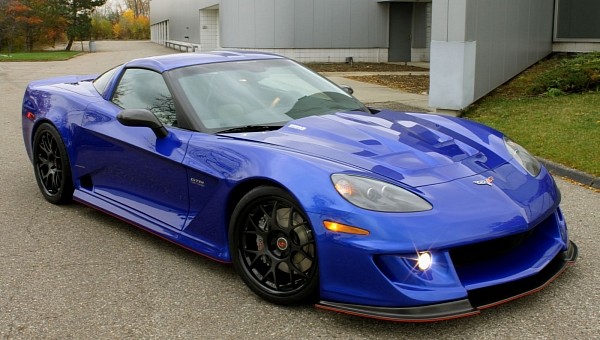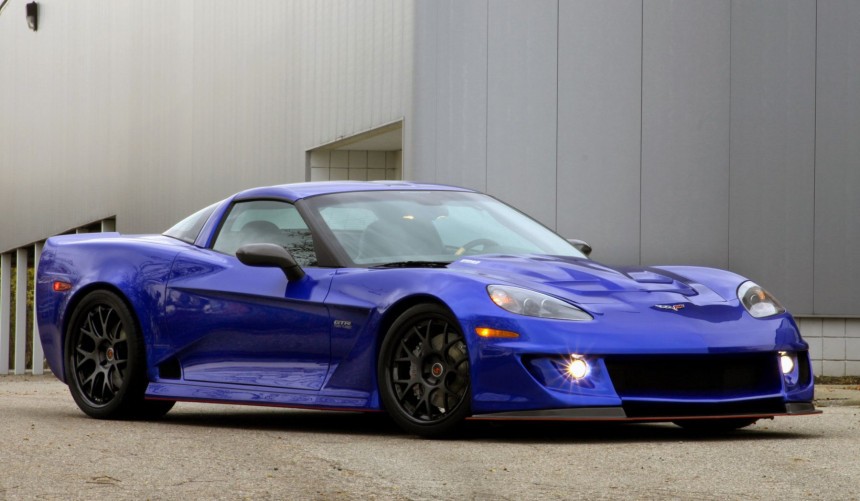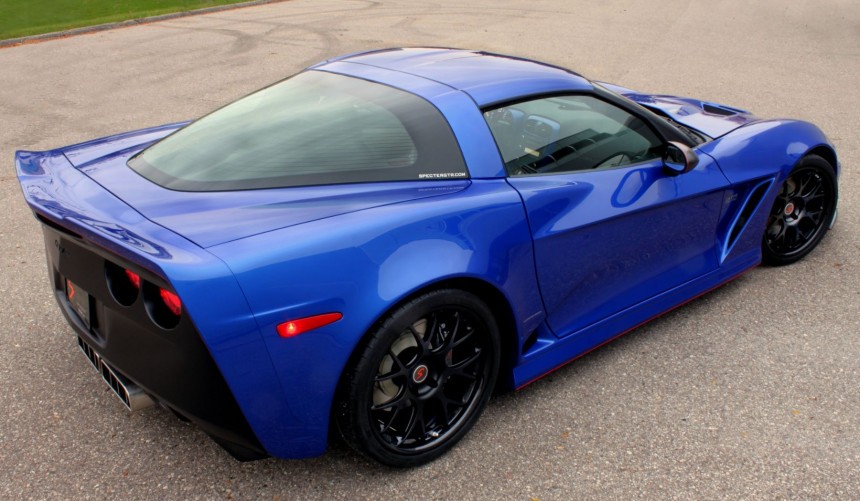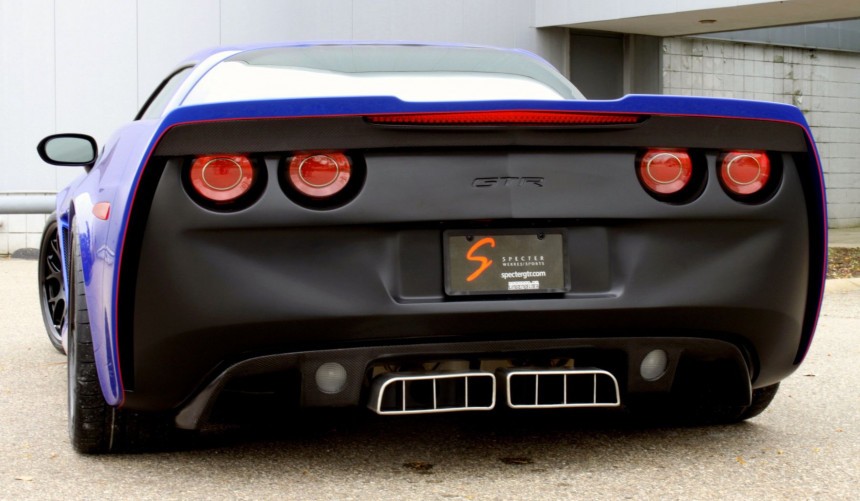Although the factory-built, high-performance ZR1 was the undisputed champion of the sixth generation, the GTR by Specter Werkes/Sports (SWS) was a worthy challenger.
Unleashed on public roads in 2005, the C6 wasn’t a mind-blowing improvement over the previous model. Except for the exposed headlights, it looked a lot like its predecessor, and although it was powered by a new engine, the initial 50-hp increase was nothing spectacular.
Things improved when the 505-hp Z06 was introduced a year later and the minds of Corvette enthusiasts were eventually blown in late 2008 when Chevy officially announced the supercar slaying, 638-hp ZR1.
Of course, apart from GM’s factory-build performance versions, the bulk of traditional Chevy tuners released their own custom-built, limited-series models which aimed to make the latest iteration of America’s most famous sports car even more impressive. Some focused solely on performance improvements, while others went for the full bespoke treatment.
One of the most impressive coachbuilt C6 was put together by Troy, Michigan-based Specter Werkes/Sports and it looked much like a road-legal version of the American Le Mans Series GT1 and 24 Hours of Le Mans GTE-Pro champion, the fearsome C6.R.
Now unfortunately defunct, Specter established itself as one of the country’s premier Corvette specialists with builds such as the C5-based GTR, a subtly widened, yet intricately upgraded ‘Vette that was so good that both Dale Earnhardt Sr. and Jr. brought one.
For the sixth generation, the SWS team led by founder Jeff Nowicki who used to design IMSA cars for GM during the 1990s wanted to deliver not just a successor to the aforementioned GTR, but a fully coachbuilt C6 that would look better than any factory-build version.
To do this, every single stock body panel except for the roof and rear hatch was masterfully reshaped. Similar to what Italian coachbuilders of old used to create, the new panels fit together flawlessly and combined to give the C6 a menacing, broad-shouldered appearance that somehow retained everything that GM stylists did right with the original design.
The redesigned front fascia boasting a carbon fiber splitter and the new hood with ample heat extractor-style vents made the GTR look like it was ready to eat the pavement. The aggressive look continued on each side where sharp-shaped doors and side skits popped out visually between the wider fenders. Finally, the carbon-trimmed rear end with revised taillights and gargantuan, mid-mounted exhaust tips seemed shaped to scare off tailgaters.
Apart from the body, SWS also improved the C6 Corvette’s road manners so it didn't just look like a race car but felt like one. The suspension system was beefed up while the stock brakes were replaced with StopTech six-piston calipers that hugged 15-inch (38 cm) slotted rotors at the front and a four-piston/14-inch (35.5 cm) combo in the rear.
Few can argue that the GTR looked better than GM-built beasts like the ZR1 but in terms of power output, it was initially tamer. When SWS began delivering the first units to customers in 2009, it was powered by what the company called a beefed-up, yet emissions-compliant LS3. Dubbed Matrix II, the naturally-aspirated powerplant was stroked to 416 ci (6.8 liters), received a new high-performance camshaft, and had all of its factory-built rotating parts swapped with forged components. In this configuration, it could make 535 hp and about 530 lb-ft (718 Nm) of torque, which was no match for what the stock ZR1 with its supercharged LS9 could deliver.
However, SWS stated that every car can be configured to each customer’s requirements, so if an individual desired a less eco-friendly GTR, they could deliver a Matrix II capable of easily surpassing the 650 hp mark.
Several months after the first GTR units were built, the company struck a deal with Lingenfelter and customers could order the race-inspired, coachbuit Corvette with a new engine that made it considerably faster than any factory-spec Chevy built before it. The unit in question was based on the Z06’s LS7 with an all-forged rotating assembly, lower-compression pistons, and not one but two medium-sized Garrett turbochargers that delivered around 10 psi (0.69 bar) of boost. This translated to an output of 800 hp. This means almost 200 hp more than the C6 ZR1 and only 50 hp less than the mind-engine C8 ZR1, which was introduced more than a decade later.
To own one of these beasts, customers had to pay about $35,000 (in addition to the cost of the stock Corvette it was built around) for the base package which only included chassis and bodywork customizations. With the Lingenfelter twin-turbo powerhouse installed, around $46,000 would have been added to the final bill. Adding up all the figures, a coachbuilt, Lingenfelter-powered C6 GTR could be had for $150,000 which was “only” half more than a stock ZR1.
Today, the Specter Werkes Corvette GTR remains one of the most impressive members of the C6 generation. It’s not just a tuner ‘Vette, but a true example of modern coachbuilding excellence combined with serious high-performance hardware.
You can take a virtual tour of this incredible car in the video below by Sportscarstudios
Things improved when the 505-hp Z06 was introduced a year later and the minds of Corvette enthusiasts were eventually blown in late 2008 when Chevy officially announced the supercar slaying, 638-hp ZR1.
Of course, apart from GM’s factory-build performance versions, the bulk of traditional Chevy tuners released their own custom-built, limited-series models which aimed to make the latest iteration of America’s most famous sports car even more impressive. Some focused solely on performance improvements, while others went for the full bespoke treatment.
One of the most impressive coachbuilt C6 was put together by Troy, Michigan-based Specter Werkes/Sports and it looked much like a road-legal version of the American Le Mans Series GT1 and 24 Hours of Le Mans GTE-Pro champion, the fearsome C6.R.
For the sixth generation, the SWS team led by founder Jeff Nowicki who used to design IMSA cars for GM during the 1990s wanted to deliver not just a successor to the aforementioned GTR, but a fully coachbuilt C6 that would look better than any factory-build version.
To do this, every single stock body panel except for the roof and rear hatch was masterfully reshaped. Similar to what Italian coachbuilders of old used to create, the new panels fit together flawlessly and combined to give the C6 a menacing, broad-shouldered appearance that somehow retained everything that GM stylists did right with the original design.
Apart from the body, SWS also improved the C6 Corvette’s road manners so it didn't just look like a race car but felt like one. The suspension system was beefed up while the stock brakes were replaced with StopTech six-piston calipers that hugged 15-inch (38 cm) slotted rotors at the front and a four-piston/14-inch (35.5 cm) combo in the rear.
Few can argue that the GTR looked better than GM-built beasts like the ZR1 but in terms of power output, it was initially tamer. When SWS began delivering the first units to customers in 2009, it was powered by what the company called a beefed-up, yet emissions-compliant LS3. Dubbed Matrix II, the naturally-aspirated powerplant was stroked to 416 ci (6.8 liters), received a new high-performance camshaft, and had all of its factory-built rotating parts swapped with forged components. In this configuration, it could make 535 hp and about 530 lb-ft (718 Nm) of torque, which was no match for what the stock ZR1 with its supercharged LS9 could deliver.
Several months after the first GTR units were built, the company struck a deal with Lingenfelter and customers could order the race-inspired, coachbuit Corvette with a new engine that made it considerably faster than any factory-spec Chevy built before it. The unit in question was based on the Z06’s LS7 with an all-forged rotating assembly, lower-compression pistons, and not one but two medium-sized Garrett turbochargers that delivered around 10 psi (0.69 bar) of boost. This translated to an output of 800 hp. This means almost 200 hp more than the C6 ZR1 and only 50 hp less than the mind-engine C8 ZR1, which was introduced more than a decade later.
To own one of these beasts, customers had to pay about $35,000 (in addition to the cost of the stock Corvette it was built around) for the base package which only included chassis and bodywork customizations. With the Lingenfelter twin-turbo powerhouse installed, around $46,000 would have been added to the final bill. Adding up all the figures, a coachbuilt, Lingenfelter-powered C6 GTR could be had for $150,000 which was “only” half more than a stock ZR1.
Today, the Specter Werkes Corvette GTR remains one of the most impressive members of the C6 generation. It’s not just a tuner ‘Vette, but a true example of modern coachbuilding excellence combined with serious high-performance hardware.
You can take a virtual tour of this incredible car in the video below by Sportscarstudios











